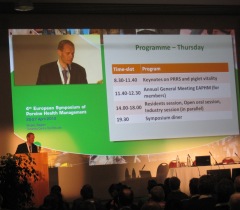Bruges pig vet symposium attracts record of 937 delegates

The European Symposium for Porcine Health Management, held in Bruges last week, can be considered an unexpected success. Instead of an expected 300-400 delegates, 937 made it to the Belgian city.
The total number of visitors to the congress, jointly organised by the European Association of Porcine Health Management (EAPHM) and the European College of Porcine Health Management, was even about 1,000 if also the press and exhibitors were counted, said organiser Prof Dr Dominiek Maes, Ghent University.
Maes told it was a real challenge to accommodate the extra number of delegates. The Site Oud St Jan, in the heart of Bruges, originally provided place for a maximum of 550 people. He said, “A large tent was placed in the inner court of the venue, and another large room, originally meant for exhibitors and coffee breaks, was used for the lectures.”
In this way, the delegates could simultaneously follow the presentations on screens.
Delegates
Maes continued, “Delegates came from 33 countries. About 130 were from Belgium, another 40-60 from European countries like Germany, the Netherlands, France, Spain, Denmark, UK, Italy – but there were delegates from all over the world, like e.g. USA, Canada, Brazil, Australia Thailand and Russia.”
Maes named several reasons for the success of the congress, like the central location of Bruges, the medieval atmosphere of the city, a general growing interest for the symposium, and the strong programme of the previous editions of the symposium.
Perhaps the location of the upcoming International Pig Veterinary Society congress, in Jeju, South Korea, may have also played a role – as travelling to Asia could be costly for many European veterinarians.
Scientific programme
Maes said the good scientific programme was part of the explanation of the well-attended event. The presentations’ quality as well as high quality subsequent discussion had pleased him.
Maes said, “One major theme was the responsible use of antimicrobials. Speakers representing the pharmaceutic industry, the pig sector, legislation, veterinary practitioners, human medicine and academia gave their views on the topic. Human and veterinary medicine should work together instead of point to each other. to reach a minimal use of antibiotics. Key was the message that if pig producers want to be producing pigs profitably with minimal use of antibiotics, good management practices are key.”
PRRS
The issue of Porcine Reproductive and Respiratory Syndrome (PRRS) received quite some attention, in presentations by Bob Morrison (University of Minnesota, USA) and Albert Vidal Heras (Lleida, Spain). Maes said, “Especially in the American situation, it has become clear that the location of a pig farm is vital. Increasing numbers of pig farms use air filtration. This does not 100% prevent against re-infection with PRRS, but it does, together with other biosecurity measures, significantly reduce the chances of infection.”
Piglet vitality
Ethically – the theme of piglet vitality was discussed, as especially in Denmark, public discussion has sprang up due to high percentages of stillborn piglets. The theme was introduced by Emma Baxter (Newcastle University, UK) and Peter Sandøe (Copenhagen, Denmark).
Maes said, “There has been a strong breeding focus on large litter sizes – nowadays, however, piglet vitality is also becoming a parameter. When grown pigs are slaughtered for consumption, then this is useful, hence ethical. It is ethically difficult to understand, however, why so many piglets should be born dead or die shortly after birth.”
Reproduction
Methods to better diagnose reproductive failure in sows were discussed by Johannes Kauffold (Germany), and Daisy Van Rompaey (Ghent University) gave a nice overview of the importance of Chlamydia infections in pigs.
Brachyspira
Brachyspira infections, leading to swine dysentery, were also discussed. Australia’s David Hampson (Perth University, Australia) spoke about this theme, as did Pedro Rubio (León University, Spain). Maes told, “Prevention of disease entry by very strict biosecurity measures should be the first focus. If herds become infected, in many cases, eradication, although not that simple, is the best option. More and more strains show antimicrobial resistance, and there is no commercially available vaccine yet, although in Spain work is in progress.”
Most of the presentations can be viewed online for members of the EAPHM as from about May 8, at the website www.eaphm.org.
The next edition of the European Symposium for Porcine Health Management, again organised jointly, will be held in Edinburgh, UK, from 22-24 May, 2013.
An extensive report of the symposium will be published in Pig Progress 28.05.
Related website:
• European Symposium for Porcine Health Management











